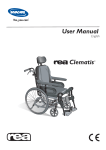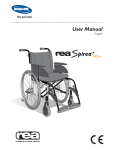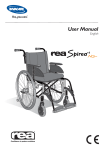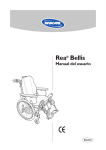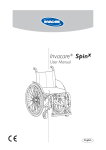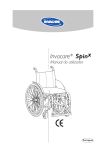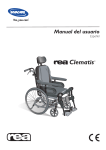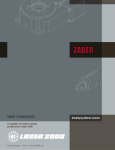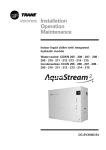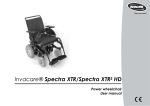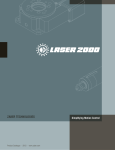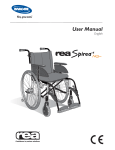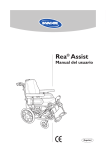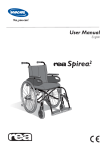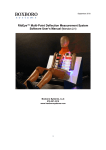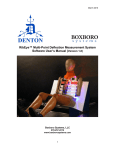Download Transport of wheelchairs and users in vehicles, Pre
Transcript
Transport of wheelchairs and users in vehicles Pre-sale information English Introduction.................................................................3 General Safety Rules..................................................4 How to transport your specific wheelchair..........7 The Rea™Azalea®family............................................8 Rea Bellis.....................................................................12 Invacare Blade+.........................................................16 Rea Clematis..............................................................18 Rea Focus....................................................................22 Invacare SpinX...........................................................25 Rea Spirea2..................................................................29 Rea Spirea3..................................................................32 Rea Spirea4 NG.............................................................35 XLT...............................................................................39 2 Copyright© Invacare Rea AB Rev. 3 2010 Introduction Invacare has continuously worked to improve the safety in all our products for the users in different everyday situations. This has, among other things, meant that Invacare since the mid 1990’s has let accredited research institutes crash test several of the manual wheelchair models. With this document we would like to inform you about the transport of wheelchairs with seated users in vehicles that are especially adapted for this purpose. First and foremost, we would like to point out that it is always the safest option for the user to be transported in the vehicle’s regular seat fastened with the regular safety belt. Invacare cannot recommend transport seated in the wheelchair. But, we are aware that there are users and situations that require vehicle transport seated in the wheelchair. In these cases, the safety rules in this brochure must be followed in order to reduce the risk of injury in the case of an accident. The wheelchairs shown in this brochure have been tested according to the specifications in ISO 7176-19 “Wheeled mobility devices for use as seats in motor vehicles”. This means that they have been through and met the requirements in a standard test of one possible situation – full frontal collision in 48 km/h with a deceleration of 20 g and a 75 kg test dummy. The test standard ISO 7176-19 is developed by authorities and specialists and it states a minimum demand on wheelchairs regarding transport in vehicles. This standard is updated regularly as knowledge and experience increases. In reality, an incident will be different from the circumstances in a test laboratory environment. For example will speed, impact angle, configuration of the chair, user weight and deceleration probably vary. Invacare declines any responsibility for the outcome of a possible accident where our products are involved. We have chosen to test what we believe to be a frequently occurring configuration with common adjustments made. The tested configuration can be found in the test protocols later on in this brochure. Configurations and accessories that are unsuitable for seated transport in a vehicle are mentioned under the general safety rules or in relation to each wheelchair model. Copyright© Invacare Rea AB Rev. 3 2010 3 General Safety Rules These rules must be followed in those cases where the user is transported while seated in his/her wheelchair. More detailed information might be available in the user manual for the specific wheelchair model. 1. 2. 1.The wheelchair and user should be transported forward-facing in the direction of travel. All auxiliary equipment such as tables, trunk support, abduction cushion, drip stand, harness etc should be removed and stored safely so that they do not injure anyone during any kind of incident. 2. The wheelchair should be secured in the vehicle with a 4-point restraint system. The user should wear a wheelchairanchored pelvic belt and a 3-point safety belt secured in the vehicle. Both the 4-point restraint system and the 3-point safety belt should be approved according to ISO-10542-2. In wheelchairs for passive users, the seat of the wheelchair should be positioned horisontally and the back should be as vertical as possible. 3. 3.The tie-down points on the wheelchair where the restraint system straps should be placed are marked with this symbol. 4 Copyright© Invacare Rea AB Rev. 3 2010 4. 4. In order to be used as a seat during transport in a vehicle, the wheelchair must be equipped with a pelvic belt. The pelvic belt should be used during transport in addition to the safety restraints installed in the vehicle, see point 2. 5. 5. The vehicle's safety belt should fit as tightly across the user's body as possible without discomfort. The upper part of the safety belt should fit over the user's shoulder as illustrated. No part of the safety belt must be twisted. 6. 6. The pelvic part of the 3-point safety belt must be worn low across the pelvis so that the angle of the pelvic belt is within the preferred zone (A) of 30° to 75° to the horizontal. A steeper angle is preferred, but never exceeding 75°. Copyright© Invacare Rea AB Rev. 3 2010 5 6 7. 7. The 3-point safety belt must not be held away from the user's body by parts of the wheelchair such as armrests or wheels etc. 8. 8. When a wheelchair is equipped with a neckrest or a headrest it should be adjusted in a high position as shown in the picture during vehicle transport. Please note that for some models it is obligatory to have a headrest fitted on the wheelchair if it is going to be used as a seat during transport in a vehicle. Copyright© Invacare Rea AB Rev. 3 2010 How to transport your specific wheelchair These products manufactured by Invacare Rea have been tested in accordance with and met the requirements in ISO 7176-19 Please note that not all configurations of these models are appropriate for transport. In the following pages you will learn how to attach each model properly when transported. You will also find information on how to fold your wheelchair when transporting it as luggage. More detailed information on each model can be found in the user’s manual. Rea™ Azalea® Invacare® Blade+ ™ ™ Rea Bellis Rea™ Spirea2® Rea™ Spirea3® Rea™ Spirea4 NG® Rea™ Clematis Invacare® SpinX® Rea™ Focus™ Invacare® XLT® Copyright© Invacare Rea AB Rev. 3 2010 7 The Rea™Azalea®family RESTRAINT METHODS A. Frontal restraints with straps 1. Connect the frontal straps around the castor attachment. See pic A. 2. Release brakes and tension front straps by pulling the wheelchair backwards. Reapply wheelchair brakes. B B. Rear restraints 1. Attach the snap hooks on the rear straps to the vertical rear tube by the rear wheel attachment. 2. Tighten the straps. A C. Fastening of pelvic belt and safety belt 1. Check that the pelvic belt on the wheelchair is correctly fastened. 2. Fasten the 3-point safety belt around the user. If the wheelchair is equipped with a harness, this cannot be used during transport in a vehicle. 8 Copyright© Invacare Rea AB Rev. 3 2010 TEST REPORT FROM DYNAMIC SAFETY RESTRAINT TEST Test No Rea Azalea: Date: P600377B 10/02/2006 Customer: Invacare Rea AB Test No Rea Azalea Assist: Date: P600662A 23/02/2006 Customer: Invacare Rea AB Test No Rea Azalea Assist Tall: Date: P702421A 22/05/2007 Customer: Invacare Rea AB Test No Rea Azalea Tall: Date: P702421B 22/05/2007 Customer: Invacare Rea AB Test No Rea Azalea Minor: Date: P801009B 25/02/2008 Customer: Invacare Rea AB Pulse specification ISO 7176-19 / ISO-10542 Wheelchair Manufacturer: Model: Configuration: Safety restraint device manufacturer: Unwin Safety Systems Model: WWR/ATF/K/R + WWR/HD/ATF/K/R Attachment device: Unwin Low Profile Rail Configuration: 4 Pt. Restraint User safety belt: Manufacturer: Model: Unwin Safety Systems QIR/3H/ATF/WH Testdummy: Hybrid III Weight: 76 kg Chassis: Weight: Backrest: Seat: Armrest: Legrest: Rear wheel: Castor: Accessories: SW44 / SD44 34,5 kg Flex2 fixed with Mistral2 cushion Bris Height adjustable AA Alu2003 24" pneumatic / 16” pneumatic 200 x 30 mm Calfpads, heel straps head-/ neckrest. Test configuration Invacare Rea AB Rea Azalea, Assist, Tall and Minor Forward facing The safety restraint devices used in this test must be approved according to ISO10542. Invacare’s business partner in this domain is Unwin Ltd UK, a quality manufacturer of safety restraint devices for wheelchairs. Copyright© Invacare Rea AB Rev. 3 2010 9 How to disassemble your Azalea to transport it as luggage 1. The Rea™ Azalea is easy to prepare for transport. 1. Backrest Remove the backrest cushion by pulling it forwards, thus separating the Velcro straps. Loosen both knobs (A) and pull the backrest directly upwards. Lay the backrest on the seat, where it can remain during transport of the wheelchair. Where applicable, detach the push handles. Be careful with the cables that run from the rear wheel to the push handles. When detaching the backrest and placing it on the seat, try to make sure that the cables hang freely. A B 2. 2. Push handles braced. Loosen the two knobs (B). Do not touch these knobs! 3. Legrests The legrests are loosened by pushing the lever (C) forwards whilst turning the legrests outwards. You can then simply lift off the legrests. 3. C 4. 4. Footrests The footrests are loosened by pushing the handle (D) forwards or sidewards whilst turning the footrests outwards. You can then simply lift off the footrests. D 10 Copyright© Invacare Rea AB Rev. 3 2010 4. 4. Armrests, Pull them straight up. 5. 5. Rear wheels Remove the rear wheels by pushing buttom (A) and pulling the wheel straight out. A 6. Copyright© Invacare Rea AB Rev. 3 2010 6. Lifting the wheelchair Always lift the wheelchair by gripping the frame at the points shown in the diagram. Never lift the wheelchair by the removable armrests or the footrests. 11 Rea™Bellis™ RESTRAINT METHODS B Rea™ Bellis C A. Frontal restraints with straps 1. Connect the frontal straps around the main frame of the wheelchair. If the straps have snap hooks, connect them to the transport attachements. 2. Release brakes and tension front straps by pulling the wheelchair backwards from the rear. Re-apply wheelchair brakes. B. Rear restraints 1. Attach the snap hooks on the rear straps to the transport attachments on the rear frame. 3. Tighten the straps. C. Fastening of pelvic belt and safety belt 1. Check that the pelvic belt on the wheelchair is correctly fastened. 2. Fasten the 3-point safety belt over the user. A B Rea™ Bellis Transport C A. Frontal restraints with straps 1. Connect the frontal straps around the main frame of the wheelchair. If the straps have snap hooks, connect them to the transport attachements. 2. Release brakes and tension front straps by pulling the wheelchair backwards from the rear. Re-apply wheelchair brakes. B. Rear restraints 1. Attach the snap hooks on the rear straps to the transport attachments on the rear wheel attachment. 3. Tighten the straps. C. Fastening of pelvic belt and safety belt 1. Check that the pelvic belt on the wheelchair is correctly fastened. 2. Fasten the 3-point safety belt over the user. A 12 Copyright© Invacare Rea AB Rev. 3 2010 How to disassemble your Bellis™ to transport it as luggage 1. A B The Rea™ Bellis is easy to prepare for transport. 1. Backrest Remove the back cushion by pulling it forwards, thus separating the Velcro strops. Loosen both knobs (A) and pull the backrest directly upwards. Lay the backrest on the seat, where it can remain during transport of the wheelchair. Where applicable, detach the push handles. Be careful with the cables that run from the rear wheel to the push handles. When detaching the backrest and placing it on the seat, try to make sure that the cables hang freely. 2. 2. Push handles braced. Loosen the two knobs (B). The height of the handles can be adjusted simply by pulling the handles upwards or pushing them downwards. 3. Legrests The legrests are loosened by pushing the lever (C) forwards whilst turning the legrests outwards. You can then simply lift off the legrests. 3. C Copyright© Invacare Rea AB Rev. 3 2010 13 4. 4. Footrests The footrests are loosened by pushing the handle (C) forwards or sidewards whilst turning the footrests outwards. You can then simply lift off the footrests. C 5a. 5a. Armrests, Flip-up In order to loosen the armrests, you must first fold them upwards by pushing lever (A) upwards and moving the armrests straight upwards. It is then simple to remove them from the wheelchair. A 5b. 5b. Armrests, height adjustable and detachable Pull them straight up. 6. 6. Rear wheels Remove the rear wheels by pushing button (B) and pulling the wheel straight out. B 14 Copyright© Invacare Rea AB Rev. 3 2010 TEST REPORT FROM DYNAMIC SAFETY RESTRAINT TEST Test no Date 09KM 07/03/00 Customer: Invacare® Rea™® AB Test no Date P300998A 19/02/03 Customer: Invacare® Rea™® AB Test no Date F415424B 24/08/04 Customer: Invacare® Rea™® AB Pulse specification ISO/DIS 7176/19 (December 1999) (Rea™® Bellis™) ISO/DiS 7176-19 and ISO 10542 (February 2003) (Rea™® Bellis™ Transport) ISO/DiS 7176-19 and ISO 10542 (August 2004) (Rea™® Bellis™) Wheelchair Manufacturer: Model: Mass: Configuration: Invacare Rea™ AB Rea™® Bellis™ and Rea™® Bellis™ Transport 38,6 kg Forward facing Manufacturer: Model: Attachment: Configuration Unwin Safety Systems 4 Pt. WWR/ATF/K/R Unwin LowProfile Rail 4 Pt. Restraint Manufacturer: Model: Unwin Safety Systems Double Inertia, ATF, 3 Pt Assy with short third point for Inertia and Wheelchair Safety restraint device User safety belt Stalk Test dummy Hybrid II (LC) Hybrid III Mass: Rea™® Bellis™ Rea™® Bellis™ Transport 76 kg Test configuration Chassie: Backrest: Seat: Armrest: Legrest: Rea™r wheel: Castor: Accessories: Tested: Medium Mistral, C11-Laguna, Fixed backrest, Mistral2 Mistral, Tromb Nice, Fixed, Fixed 24” pneumatic, 16” pneumatic 140x37, 200x45 M, Neckrest, Heel straps 200-03-07, 2003-07-01, 200-08-24 Copyright© Invacare Rea AB Rev. 3 2010 15 Invacare® Blade+® RESTRAINT METHODS Frontal restraints with straps 1. Connect the frontal straps around the castor attachment. See pictures for exact placement. 2. Release brakes and tension front straps by pulling the wheelchair backwards. Re-apply wheelchair brakes. Rear restraints 1. Attach the snap hooks on the rear straps to the vertical rear tube by the rear wheel attachment. 2. Tighten the straps. For transit versions of the wheelchair the attachment points are the same. Swing-away foot rests Outrigged castors 16 Copyright© Invacare Rea AB Rev. 3 2010 TEST REPORT FROM DYNAMIC SAFETY RESTRAINT TEST Test No S7333 Pulse specification ISO 7176-19 Wheelchair dynamic hyge sled test Wheelchair Manufacturer: Model: Configuration: Safety restraint device: Koller 4 point system User safety belt: Koller 3 point system Testdummy: Hybrid II 5th percentile Copyright© Invacare Rea AB Rev. 3 2010 Customer: Invacare UK Invacare UK Invacare Blade Plus Forward facing 17 Rea™Clematis® RESTRAINT METHODS A. Frontal restraints with straps 1. Connect the frontal straps around the castor attachment. See pic A. 2. Release brakes and tension front straps by pulling the wheelchair backwards. Re-apply wheelchair brakes. B. Rear restraints 1. Attach the snap hooks on the rear straps to the vertical rear tube by the rear wheel attachment. 2. Tighten the straps. C. Fastening of pelvic belt and safety belt 1. Check that the pelvic belt on the wheelchair is correctly fastened. 2. Fasten the 3-point safety belt around the user. If there is no pelvic belt in on the wheelchair the user must transfer to the seat of the vehicle. The safety belt should not be kept from the user’s body by the parts of the wheelchair. Never use the harness and pelvic belt in a vehicle as a safety belt. A belt designed for transport in vehicles must always be used. 18 Copyright© Invacare Rea AB Rev. 3 2010 TEST REPORT FROM DYNAMIC SAFETY RESTRAINT TEST (ISO-7176-19) Test No. Customer: Date P906579A Invacare Rea AB 2009-10-20 Pulse specification/CFC60 ISO-7176-19:2009 & ISO-10542 Wheelchair Manufacturer: Invacare Rea AB Model: Rea™ Clematis Weight: 32 kg Configuration: Forward facing Safety restraint device and user safety belt Manufacturer: Unwin Safety Systems Model: C120 and 3PTF Attachment device: Unwin Low Profile Rail Test dummy Hybrid III Weight: 79.1 kg Test configuration Chassis: Height 45 cm Backrest: AA Laguna 2 with neckrest Seat: AA with pelvic belt Armrest: Height adjustable Legrest: Alu 2008 Rear wheel: 24” pneumatic Castor: 200 x 45 mm Accessories: Heel strap, calf pad, anti-tip device Copyright© Invacare Rea AB Rev. 3 2010 19 How to disassemble your Clematis to transport it as luggage It is easy to prepare your Rea™ Clematis® for transport. Remove both the leg- and armrests. Fold the wheelchair and remove the wheels (if you have a chair with quick release wheels). You now have a chair that will easily fit into the luggage of a car. 1. Rea™ Clematis® is not intended to be transported with the user sitting in the chair. 1. Armrests The armrest has an auto-lock. Press the spring button (A) before removing the armrest. A 2. 2. Legrests The legrests are loosened by pushing the lever (B) forwards whilst turning the legrests outwards. You can then simply lift off the legrests. B 3. Rearwheels 3. Remove the rear wheels by pushing button (C) and pulling the wheel straight out. C 4. Neckrest 4. Remove the neckrest by loosening the knob (C) and lift it straight up. C 20 Copyright© Invacare Rea AB Rev. 3 2010 5. 5. Backrest Fold the backrest forwards by removing pin (D). D 6. 6. If you want to reduce the height of the chair even more, remove the pin (G) from the lower attachment of the lower gas piston. Be careful not to trap your fingers between seat and frame. Copyright© Invacare Rea AB Rev. 3 2010 21 Rea™Focus™ RESTRAINT METHODS C B Rea™ Focus A. Frontal restraints with straps 1. Connect the frontal straps around the frontal part of the frame. 2. Release brakes and tension front straps by pulling the wheelchair backwards from the rear. 3. Re-apply wheelchair brakes. B. Rear restraints 1. Attach the snap hooks on the rear straps to the frame just above the rear wheel attachments. 2. Tighten the straps. C. Fastening of pelvic belt and safety belt 1. Check that the pelvic belt on the wheelchair is correctly fastened. 2. Fasten the 3-point safety belt over the user. A 22 Copyright© Invacare Rea AB Rev. 3 2010 TEST REPORT FROM DYNAMIC SAFETY RESTRAINT TEST (ISO-7176-19) Test no Date P303194B 2003-09-19 Pulse specification Testing to be carried out ISO-7176-19 Customer: Invacare Rea AB Wheelchair Manufacturer: Model: Weight: Configuration: Invacare Rea AB Rea™ Focus 18.5 kg Forward facing Safety restraint device Manufacturer: Model: Attachment device: Unwin Safety Systems 4 Pt WWR/ATF/K/R Unwin Low Profile Rail User safety belt: Manufacturer: Model: Unwin Safety Systems 3 Pt WWR/HD/ATF/K/R Test dummy Hybrid III Weight: 76.5 kg Chassie: Backrest: Seat: Armrest: Legrest: Rear wheel: Castor: Accessories: Tested: Height 43 cm Fixed With seat extender Height adjustable Fixed 24" pneumatic 150 x 27 mm Heel strap 2003-09-19 Test configuration The safety restraint devices used in this test must be approved according to ISO10542. Invacare’s business partner in this domain is Unwin Ltd UK, a quality manufacturer of safety restraint devices for wheelchairs. Copyright© Invacare Rea AB Rev. 3 2010 23 How to disassemble your Focus™ to transport it as luggage 1. Start by removing the armrests. 1. A B Flip up armrests Press the button (A), swing up the armrest. Lift it straight up (you may need to hold it slightly forward then lift it straight up) (B). Detachable armrests When having detachable one´s, just lift them up. 2a. B 2. Footrests and legrests 2a. Remove the footrests by pressing the level (B), whilst turning the footrests outwards or inwards and pull them straight up. Be careful not to trap your fingers between frame and footrest. 2b. C 2b. Remove the legrests by pressing the level (C) forwards, whilst turning the legrests outwards and pull them straight up. Be careful not to trap your fingers between frame and legrest. 3–4. The Brake lever Please note the brake lever handle will have a certain amount of free play. Without activating the brake, the lever will fold up automatically when the legrest has been moved to its outward position. To activate the brake just push the lever forwards. 3. Backrest bar Press the indicated small knob and fold down the backrest bar. 5. 4. Fold the seat by always pulling the handle in the middle of the seat right up. Be careful not to trap your fingers between the seat-halves! 5. Remove the rear wheels by pressing the button in the centre of the hub whilst pulling the wheel away from the wheelchair. Finally, fold the anti-tip devices upwards. 24 Copyright© Invacare Rea AB Rev. 3 2010 Invacare® SpinX™ RESTRAINT METHODS B C A. Front restraints with straps 1. Connect the front straps around the front tube of the frame, just above the lower polyamid block, see picture A. 2. Release brakes and tension front straps by pulling the wheelchair backwards. Reapply wheelchair brakes. B. Rear restraints 1. Attach the snap hooks of the rear straps around the rear tube of the frame, just above the rear wheel attachment, see picture B. 2. Tighten the straps. A C. Pelvic belt and 3-point safety belt 1. Check that the pelvic belt is correctly attached to the wheelchair, adjust the length and fasten it around the user. 2. Fasten the 3-point safety belt around the user.. In order to use your SpinX as a seat during transport it must be equipped with a transport kit. This transport kit must be included when your chair is ordered from the factory and it consists of two blocks mounted on the frame and four stickers indicating the tiedown points for the restraints. Copyright© Invacare Rea AB Rev. 3 2010 25 How to disassemble your SpinX to transport it as luggage 1. B When you are transporting the Invacare® Spinx you can easily remove certain parts to make the chair smaller and lighter. 1. Start by removing the armrests. A Flip up armrests Press the button (A), swing up the armrest. Lift it straight up. You may need to hold it slightly forward then lift it straight up (B). 2a. Detachable armrests When you have detachable armrests, just lift them up. B Leg rests 2a.Remove the fixed legrests by pressing the level (B), whilst turning the footrests outwards or inwards and pull them straight up. C 2b.Remove the adjustable legrests by pressing the level (C) backwards, whilst turning the legrests outwards and pull them straight up. 2b. Be careful not to trap your fingers between frame and legrest. 3. Alt. 1 Alt. 2 3. Folding the chair Alternative 1: If you have a backrest bar first detach the left hand side of the backrest stay by depressing the catch on the inside of the left hand bracket and then rotate the stay downwards. Fold the chair by pulling the seat upwards. Alternative 2: After removing the wheels, flip down the backrest by grabbing the wire at the lower back of the backrest and twisting it to release the backrest locking. 4. Please be careful when folding the backrest forward onto the seat as there is a risk of finger entrapment. 4. Remove the rearwheels by pressing the button in the centre of the hub whilst pulling the wheel away from the wheelchair. 26 Copyright© Invacare Rea AB Rev. 3 2010 TEST REPORT FROM DYNAMIC SAFETY RESTRAINT TEST Test no: Date: P602670C 21/06/2006 Pulse specification: ISO 7176-19 / ISO-10542 Wheelchair: Manufacturer: Model: Configuration: Invacare Rea AB Invacare® Spinx Forward facing Safety restraint device: Manufacturer: Model: Attachment device: Configuration: Unwin Safety Systems WWR/ATF/K/R + WWR/HD/ATF/K/R Unwin Low Profile Rail 4 Pt. Restraint User safety belt: Manufacturer: Model: Unwin Safety Systems QIR/3H/ATF/WH Testdummy: Hybrid III Weight: 76 kg Chassis: Weight: Backrest: Seat: Armrest: Legrest: Rear wheel: Castor: Accessories: SW43 / SD45 20,2 kg Tension adjustable, foldable Standard 5 cm Height adjustable Fixed 80º Alu2003 24" pneumatic 140 x 37 mm Backrest stay, heel straps, pelvic belt Test configuration: Customer: Invacare Rea AB The safety restraint devices used in this test must be approved according to ISO10542. Invacare’s business partner in this domain is Unwin Ltd UK, a quality manufacturer of safety restraint devices for wheelchairs. Copyright© Invacare Rea AB Rev. 3 2010 27 TEST REPORT FROM DYNAMIC SAFETY RESTRAINT TEST Test no: Date: P604734A 23/11/2006 Pulse specification: ISO 7176-19 / ISO-10542 Wheelchair: Manufacturer: Model: Configuration: Invacare Rea AB Invacare® Spinx with passive rearwheel fixation Forward facing Safety restraint device: Manufacturer: Model: Attachment device: Configuration: Unwin Safety Systems WWR/ATF/K/R + WWR/HD/ATF/K/R Unwin Low Profile Rail 4 Pt. Restraint User safety belt: Manufacturer: Model: Unwin Safety Systems QIR/3H/ATF/WH Testdummy: Hybrid III Weight: 76 kg Chassis: Weight: Backrest: Seat: Armrest: Legrest: Rear wheel: Castor: Accessories: SW45.5/SD45 20,0 kg Tension adjustable, foldable Standard 5 cm Height adjustable Fixed 80º Alu2003 24" pneumatic 140 x 37 mm Backrest stay, heel straps, pelvic belt Test configuration: Customer: Invacare Rea AB The safety restraint devices used in this test must be approved according to ISO10542. Invacare’s business partner in this domain is Unwin Ltd UK, a quality manufacturer of safety restraint devices for wheelchairs. 28 Copyright© Invacare Rea AB Rev. 3 2010 Rea ™ ® 2 Spirea RESTRAINT METHODS C B Rea™ Spirea2 A. Frontal restraints with straps 1. Connect the frontal straps around the frontal part of the frame. 2. Release brakes and tension front straps by pulling the wheelchair backwards from the rear. 3. Re-apply wheelchair brakes. B. Rear restraints 1. Attach the snap hooks in the holes on the belt attachments. 2. Tighten the straps. C. Fastening of seat belt and safety belt 1. Check that the seat belt on the wheelchair is correctly fastened. 2. Fasten the 3-point safety belt over the user. A C B A Copyright© Invacare Rea AB Rev. 3 2010 29 How to disassemble your Spirea2 to transport it as luggage 1. 1. Start by removing the armrests. A B Flip up armrests Press the button (A), swing up the armrest. Lift it straight up (you may need to hold it slightly forward then lift it straight up) (B). Detachable armrests When having detachable one´s, just lift them up. 2a. Remove the footrests by pressing the level (B), whilst turning the footrests outwards or inwards and pull them straight up. 2a. B Be careful not to trap your fingers between frame and footrest. 2b. C 2b. Remove the legrests by pressing the level (C) backwards, whilst turning the legrests outwards and pull them straight up. Be careful not to trap your fingers between frame and legrest. 3. Concerning the brake The lever of the brake where the handle is located, have a free play. The lever folds up automatically when the legrest have been swinged to its outward position without activating the brake. To activate the brake just press respectively pull at its most forward respectively rear located position. 3. Push the seat down into a ”U” shape. Take hold of the sides of the seat and fold the chair completely. 4. If you have a backrest bar release it first by pressing on the small nob on the inside of the tube. It will automaticlly fall down to the side. 4. Remove the rearwheels by pressing the buttom in the centre of the hub whilst pulling the wheel away from the wheelchair. Finally, fold the anti-tip devices upwards (see page 23). 30 Copyright© Invacare Rea AB Rev. 3 2010 TEST REPORT FROM DYNAMIC SAFETY RESTRAINT TEST (ISO-7176-19) Test no: Date: P303194A 2003-09-19 Customer: Invacare Rea AB Test no: Date: F403233 2004-02-16 Customer: Invacare Rea AB Pulse specification Testing to be carried out ISO-7176-19 Wheelchair Manufacturer: Model: Weight: Configuration: Invacare Rea AB Rea® Spirea2, Rea® Spirea2 transport 16.4 kg Forward facing Safety restraint device Manufacturer: Model: Attachment device: Unwin Safety Systems 4 Pt WWR/ATF/K/R Unwin Low Profile Rail User safety belt: Manufacturer: Model: Unwin Safety Systems 3 Pt WWR/HD/ATF/K/R Test dummy Hybrid III Weight: 76.5 kg Test Configuration Chassie: Backrest: Seat: Armrests: Legrests: Rear wheels: Castors: Accessoires: Tested: 43/40 cm Fixed Sling seat depth adjustable Velcro adjustable in depth and shape Detachable Fixed 24" pneumatic, 16" pneumatic 150 x 27 mm Heal straps 2003-09-19, 2004-02-16 The safety restraint devices used in this test must be approved according to ISO-10542. We have chosen to work with Unwin, a well-known quality manufacturer of safety restraint devices for wheelchairs. Copyright© Invacare Rea AB Rev. 3 2010 31 Rea Spirea3 ™ ® C Rea™ Spirea3 A. Frontal restraints with straps 1. Connect the frontal straps around the frontal part of the frame. 2. Release brakes and tension front straps by pulling the wheelchair backwards from the rear. 3. Re-apply wheelchair brakes. B B. Rear restraints 1. Attach the snap hooks in the holes on the belt attachments. 2. Tighten the straps. C. Fastening of seat belt and safety belt 1. Check that the seat belt on the wheelchair is correctly fastened. 2. Fasten the 3-point safety belt over the user. A C B A 32 Copyright© Invacare Rea AB Rev. 3 2010 How to disassemble your Spirea3 to transport it as luggage 1. Start by removing the armrests. 1. Flip up armrests Press the button (A), swing up the armrest. Lift it straight up (you may need to hold it slightly forward then lift it straight up) (B). A B Detachable armrests When having detachable one´s, just lift them up 2a. Remove the footrests by pressing the level (B), whilst turning the footrests outwards or inwards and pull them straight up. 2a. B Be careful not to trap your fingers between frame and footrest. 2b. C 2b. Remove the legrests by pressing the level (C) backwards, whilst turning the legrests outwards and pull them straight up. Be careful not to trap your fingers between frame and legrest. 3. Concerning the brake The lever of the brake where the handle is located, have a free play. The lever folds up automatically when the legrest have been swinged to its outward position without activating the brake. To activate the brake just press respectively pull at its most forward respectively rear located position. 3. Push the seat down into a ”U” shape. Take hold of the sides of the seat and fold the chair completely. 4. If you have a backrest bar release it first by pressing on the small nob on the inside of the tube. It will automaticlly fall down to the side. 4. Remove the rearwheels by pressing the buttom in the centre of the hub whilst pulling the wheel away from the wheelchair. Finally, fold the anti-tip devices upwards (see page 23). Copyright© Invacare Rea AB Rev. 3 2010 33 TEST REPORT FROM DYNAMIC SAFETY RESTRAINT TEST (ISO-7176-19) Test no: Customer: Date: P601713B Invacare Rea AB 2003-09-19 Test no: Date: F403233 26-04-2006 Pulse specification ISO-7176-19 Wheelchair Manufacturer: Model: Weight: Configuration: Invacare Rea AB Rea® Spirea3 18 kg Forward facing Safety restraint device Manufacturer: Model: Attachment device: Unwin Safety Systems 4 Pt WWR/ATF/K/R Unwin Low Profile Rail User safety belt: Manufacturer: Model: Unwin Safety Systems 3 Pt WWR/HD/ATF/K/R Test dummy Hybrid III Weight: 76.5 kg Test Configuration Chassie: Backrest: Seat: Armrests: Legrests: Rear wheels: Castors: Accessoires: Customer: Invacare Rea AB 45,5/45 cm Angle adjustable Sling seat depth adjustable Velcro adjustable in depth and shape Fixed 90° Alu2003, fixed footplates 24" pneumatic, 0° camber 150 x 27 mm Backrest bar, pelvic belt The safety restraint devices used in this test must be approved according to ISO-10542. We have chosen to work with Unwin, a well-known quality manufacturer of safety restraint devices for wheelchairs. 34 Copyright© Invacare Rea AB Rev. 3 2010 Rea ™ ® 4 NG Spirea A Rea Spirea4NG A. Front restraints with straps 1. Connect the front straps around the front part of the chair’s frame. 2. Release the wheelchair’s brakes and tighten the front straps by pulling the chair backwards. 3. Brake the chair. B. Fastening at the back 1. Attach the snap hooks in the transport bracket by the back rest attachment. 2. Tighten the straps. C. Fastening the pelvic belt and safety belt 1. Check that the pelvic belt is securely fastened. 2. Fasten the car’s safety belt over the user. Note that the Rea Spirea4 NG should not be used for seated transport in a vehicle if the wheelchair is not equipped with transport brackets (A) and does not have a neckrest fitted Copyright© Invacare Rea AB Rev. 3 2010 35 HOW TO DISASSEMBLE YOUR WHEELCHAIR AHEAD OF TRANSPORT AS LUGGAGE. When you want to transport the Rea Spirea4 NG, you can easily remove certain parts to make the chair smaller and lighter. 1. 1. Start by removing the arm rests. Press in the button on the spring to loosen the arm rest and then lift it straight up. 2a. 2a. Release the foot rests by moving the lever (B) forward or towards the sides while angling the rests outwards. You can then easily lift off the foot rests. B Be careful not to trap your fingers between the frame and the foot rest. 2b. C 2b. Loosen the leg rests by pressing in the lever (C) and turning the leg rests outwards. You can then easily lift off the leg rests. Be careful not to trap your fingers between the frame and the leg rest. 3. 3. Press the seat into a U shape. Take hold of both sides of the seat frame and fully collapse the wheelchair. If you have a back rest bar, remove it first by pressing in the catch on the inside of the left bracket and then folding the bar down. 4. 36 4. Remove the drive wheels by pressing the button in the centre of the wheel while pulling the wheel away from the wheelchair. Finally, fold the anti-tip devices upwards. Copyright© Invacare Rea AB Rev. 3 2010 TEST REPORT FROM DYNAMIC SAFETY RESTRAINT TEST (ISO-7176-19) Test no: Customer: Date: PX02078A, PX03117B, PX03117D Invacare Rea AB 2010-03-17, 2010-06-14 Pulse specification ISO-7176-19:2008 Wheelchair Manufacturer: Model: Weight: Configuration: Invacare Rea AB Rea® Spirea4 NG 20,5, 21,4 kg Forward facing Safety restraint device Manufacturer: Model: Attachment device: Unwin Safety Systems 4 Pt WWR/ATF/K/R Unwin Low Profile Rail User safety belt: Manufacturer: Model: Unwin Safety Systems 3 Pt WWR/HD/ATF/K/R Test dummy Hybrid III Weight: 79,2 kg Test Configuration Chassie: Backrest: Seat: Armrests: Legrests: Rear wheels: Castors: Accessoires: 43, 45,5 cm Angle adjustable Sling seat depth adjustable Velcro adjustable in depth and shape Rio short AF 80° 24", 16’’ 150 x 29 mm Neckrest, anti-tp device. pelvic belt The safety restraint devices used in this test must be approved according to ISO-10542. We have chosen to work with Unwin, a well-known quality manufacturer of safety restraint devices for wheelchairs. Copyright© Invacare Rea AB Rev. 3 2010 37 Invacare® XLT® RESTRAINT METHODS B C A. Front restraints with straps 1. Connect the front straps around the front tube of the frame, just above the castor housing, see picture A. 2. Release brakes and tension front straps by pulling the wheelchair backwards. 3. Re-apply wheelchair brakes. B. Rear restraints 1. Attach the snap hooks of the rear straps around the rear tube of the frame, just above the rear wheel attachment, see picture B. 2. Tighten the straps. C. Pelvic belt and 3-point safety belt 1. Check that the pelvic belt is correctly attached to the wheelchair, adjust the length and fasten it around the user. 2. Fasten the 3-point safety belt around the user. A We would like to point out that there is always a risk involved in being transported seated in your wheelchair. The risk for injury during an incident increases when you have a wheelchair with a low backrest. The lower the back, the higher the risk for injury. Therefore, Invacare strongly advise against the use of XLT as a seat in a vehicle if the backrest is lower than 40 cm.. 38 Copyright© Invacare Rea AB Rev. 3 2010 TEST REPORT FROM DYNAMIC SAFETY RESTRAINT TEST TEST REPORT FROM DYNAMIC SAFETY RESTRAINT TEST TEST REPORT FROM DYNAMIC SAFETY RESTRAINT TEST Test No: P802083C Customer: Invacare® Rea™ AB Test no: P803427C Customer: Invacare® Rea™ AB Test no: P803427D Customer: Invacare® Rea™ AB Date: 27/03/2008 Date: 10/06/2008 Date:10/06/2008 Pulse specification: ISO 7176-19 / ISO-10542 Pulse specification: ISO 7176-19 / ISO 10542-1 Pulse specification: ISO 7176-19 / ISO 10542-1 Wheelchair: Manufacturer: Invacare® Rea™ AB Model: Invacare® XLT Swing Configuration: Forward facing Wheelchair: Manufacturer: Invacare® Rea™ AB Model: Invacare® XLT Active Configuration: Forward facing Wheelchair: Manufacturer: Invacare® Rea™ AB Model: Invacare® XLT Dynamic Configuration: Forward facing Safety restraint device: Manufacturer: Unwin Safety Systems Model: UN 120-3 Attachment device: Unwin Low Profile Rail Configuration: 4 Pt. Restraint Safety restraint device: Manufacturer: Unwin Safety Systems Model: UN 120-3 Attachment device: Unwin Low Profile Rail Configuration: 4 Pt. Restraint Safety restraint device: Manufacturer: Unwin Safety Systems Model: UN 120-3 Attachment device: Unwin Low Profile Rail Configuration 4 Pt. Restraint User safety belt: Manufacturer: Unwin Safety Systems Model: UN 120-3 User safety belt: Manufacturer: Unwin Safety Systems Model:UN 120-3 User safety belt: Manufacturer:Unwin Safety Systems Model:UN 120-3 Testdummy: Hybrid III Weight: 76 kg Test configuration: Chassis: SW43 / SD45 - Swing Weight: 20.2 kg Backrest: Tension- and height adjustable, foldable Seat: Standard seat cushion. Tension- and depth adjustable Armrest: Height adjustable, removable Legrest: Fixed 80º Alu2003 Rear wheel: 24" pneumatic Castor: 125x27 mm Accessories: Neckrest, pelvic belt and anti-tip device Copyright© Invacare Rea AB Rev. 3 2010 Testdummy: Hybrid III Weight: 76.5 kg Test configuration: Chassis: SW43 / SD45 - 75° Weight: 16.8 kg Backrest: Tension- and height adjustable, foldable Seat: Standard seat cushion. Tension- and depth adjustable Armrest: Height adjustable, removable Legrest: Fixed 80º Alu2003 Rear wheel: 24" pneumatic Castor: 125x27 mm Accessories: Neckrest, pelvic belt and anti-tip device Testdummy: Hybrid III Weight:76.5 kg Test configuration: Chassis: SW43 / SD45 - 90° Weight: 16.9 kg Backrest: Tension- and height adjustable, foldable Seat: Standard seat cushion. Tension- and depth adjustable Armrest: Height adjustable, removable Legrest: Fixed 80º Alu2003 Rear wheel: 24" pneumatic Castor: 125x27 mm Accessories: Neckrest, pelvic belt and anti-tip device 39 How to disassemble your XLT to transport it as luggage B B 1. Your XLT is easy to transport, many parts are removable to make the chair smaller and lighter. A 1. Start by removing the armrests. Flip up armrests Press the button (A), swing the armrest up. Lift it straight up. You may need to hold it slightly forward, then lift it straight up (B). 2a. Detachable armrests When you have detachable armrests, just lift them up. C 2a. Remove the swing away legrests by pressing the lever (C), whilst turning the footrests outwards or inwards and pull them straight up. D 2b. 2b. Remove the adjustable legrests by pressing the level (D) backwards, whilst turning the legrests outwards and pull them straight up. Be careful that you do not trap your fingers between frame and legrest. 3. 3. Remove the rear wheels by pressing the button in the centre of the hub at the same time as you pull the wheel away from the wheelchair. The procedure is the same when you replace the wheel: press the button and put the wheel back in place. It is very important that you check that the locking pin has actually locked the wheel into position when the centre button has been released. Take hold of the wheels and try to detach them. This should NOT be possible. 4. 4. Folding the chair After removing the wheels, flip down the backrest by grabbing the wire at the lower back of the backrest and twisting it to release the backrest locking. Be careful that you do not trap your fingers when you fold the backrest forward onto the seat. 40 Copyright© Invacare Rea AB Rev. 3 2010 Copyright© Invacare Rea AB Rev. 3 2010 41 42 Copyright© Invacare Rea AB Rev. 3 2010 Copyright© Invacare Rea AB Rev. 3 2010 43 Manufacturer Invacare Rea AB Växjövägen 303 S-343 71 DIÖ SWEDEN Sales Units: Danmark: Invacare A/S, Sdr. Ringvej 37, DK-2605 Brøndby Tel: (45) (0)36 90 00 00, Fax: (45) (0)36 90 00 01 [email protected] Deutschland: Invacare Aquatec GmbH, Alemannenstraße 10, D-88316 Isny Tel: (49) (0)75 62 7 00 0, Fax: (49) (0)75 62 7 00 66 [email protected] Ulrich Alber GmbH, Vor dem Weissen Stein 21, D-72461 Albstadt-Tailfingen Tel: (49) (0)7432 2006 0, Fax: (49) (0)7432 2006 299 [email protected] European Distributor Organisation: Invacare, Kleiststraße 49, D-32457 Porta Westfalica Tel: (49) (0)57 31 754 540, Fax: (49) (0)57 31 754 541 [email protected] España: Invacare SA, c/Areny s/n, Polígon Industrial de Celrà, E-17460 Celrà (Girona) Tel: (34) (0)972 49 32 00, Fax: (34) (0)972 49 32 20 [email protected] France: Invacare Poirier SAS, Route de St Roch, F-37230 Fondettes Tel: (33) (0)2 47 62 64 66, Fax: (33) (0)2 47 42 12 24 [email protected] Ireland: Invacare Ireland Ltd, Unit 5 Seatown Business Campus, Seatown Road, Swords, County Dublin Ireland Tel: (353) 1 810 7084, Fax: (353) 1 810 7085 [email protected] Italia: Invacare Mecc San s.r.l., Via dei Pini 62, I-36016 Thiene (VI) Tel: (39) 0445 38 00 59, Fax: (39) 0445 38 00 34 [email protected] 44 Nederland: Invacare BV, Celsiusstraat 46, NL-6716 BZ Ede Tel: (31) (0)318 695 757, Fax: (31) (0)318 695 758 [email protected] [email protected] Norge: Invacare AS, Grensesvingen 9, Postboks 6230, Etterstad, N-0603 Oslo Tel: (47) (0)22 57 95 00, Fax: (47) (0)22 57 95 01 [email protected] [email protected] Österreich: Mobitec Mobilitätshilfen GmbH, Herzog Odilostrasse 101, A-5310 Mondsee Tel: (43) 6232 5535 0, Fax: (43) 6232 5535 4 [email protected], austria@invacare. com Portugal: Invacare Lda, Rua Estrada Velha, 949, P-4465-784 Leça do Balio Tel: (351) (0)225 1059 46/47, Fax: (351) (0)225 1057 39 [email protected] Sverige & Suomi: Invacare AB, Fagerstagatan 9, S-163 91 Spånga Tel: (46) (0)8 761 70 90, Fax: (46) (0)8 761 81 08 [email protected] [email protected] Switzerland: Mobitec Rehab AG, Benkenstrasse 260, CH-4108 Witterswil Tel: (41) (0)61 487 70 80, Fax: (41) (0)61 487 70 81 [email protected] [email protected] United Kingdom: Invacare Limited, Pencoed Technology Park, Pencoed, Bridgend CF35 5HZ Switchboard Tel: (44) (0)1656 776200, Fax: (44) (0)1656 776201 Customer services Tel: (44) (0)1656 776222, Fax: (44) (0)1656 776220 [email protected] Copyright© Invacare Rea AB Rev. 3 2010 Art. No. 1533992 rev. 3 2010-07-01 Belgium & Luxemburg: Invacare nv, Autobaan 22, B-8210 Loppem Tel: (32) (0)50 83 10 10, Fax: (32) (0)50 83 10 11 [email protected]












































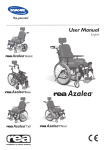
![Deep Time User Manual ver.1.3 [ENG]](http://vs1.manualzilla.com/store/data/005775250_1-8eb61345983a4e3ef84e4b82ef32f1cf-150x150.png)
